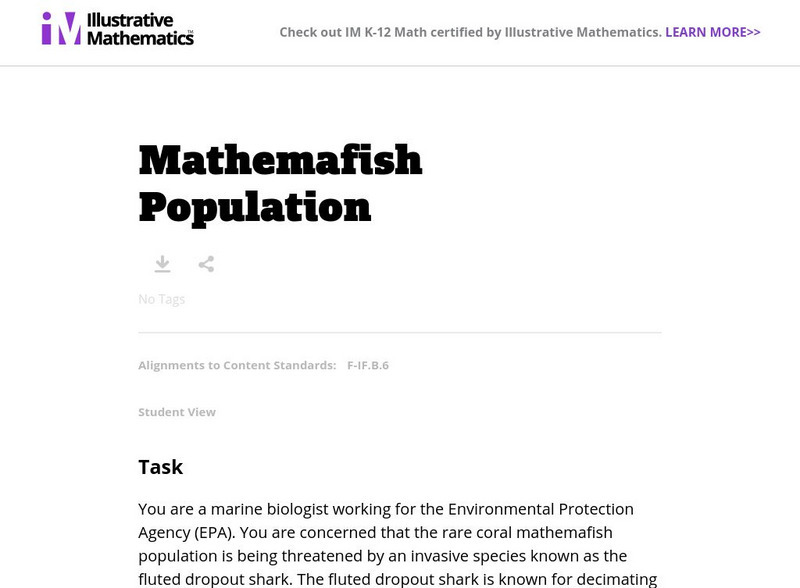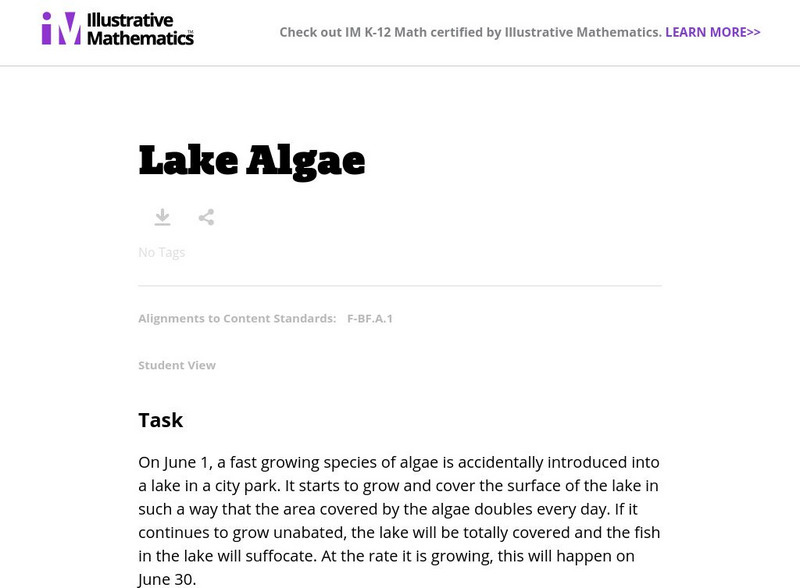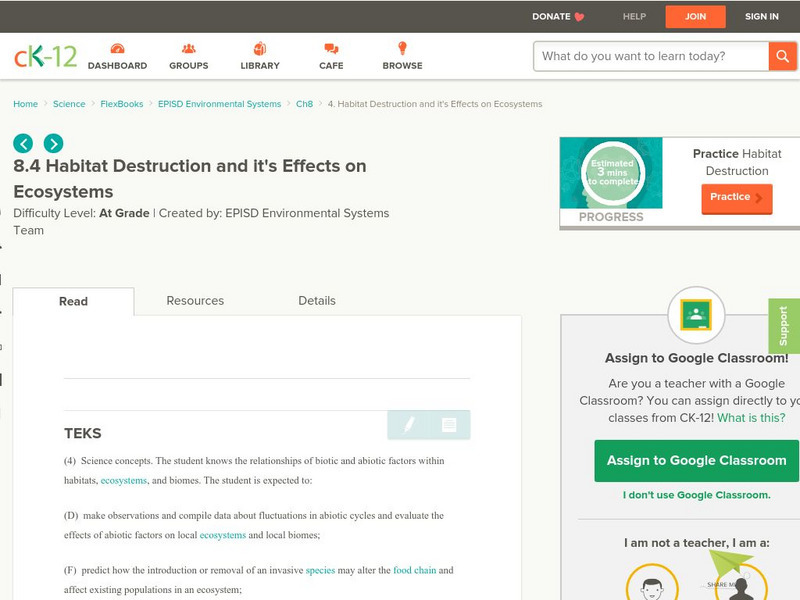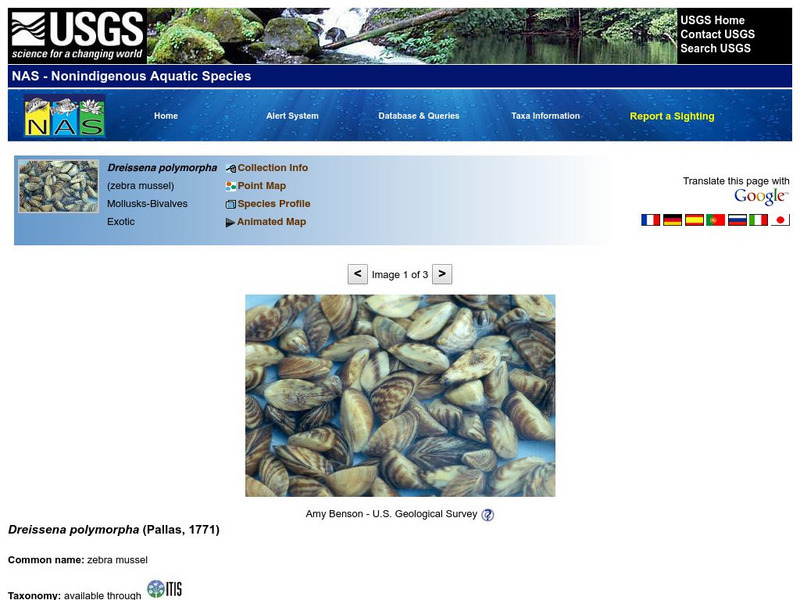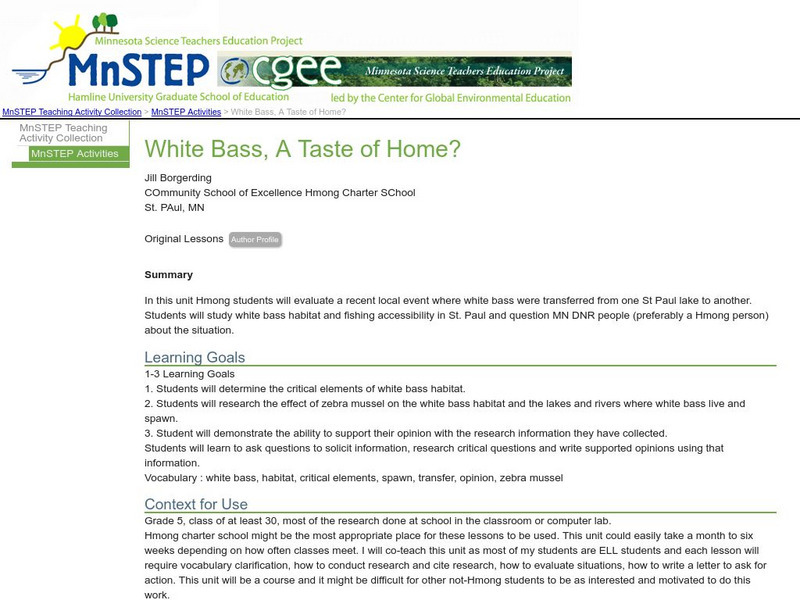US Geological Survey
U.s. Geological Survey: Connect the Dots With Science
Connect-the-dots science pages providing useful and helpful information regarding pollinators, endangered species, and invasive species. [PDF] Links to other handy tools, including coloring pages, trivia, stories, games and fun projects.
University of Florida
Florida Museum of Natural History: Pterois Volitans: Red Lionfish
The Florida Museum of Natural History presents this informative article on the Red Lionfish which is native to reef habitats of the Indo-Pacific. General information including photographs and a habitat map.
Illustrative Mathematics
Illustrative Mathematics: F Le Snail Invasion
In this task, students investigate the power of exponential growth in this real-world example of an invasive species that was introduced to Florida in 1966, a giant snail. Aligns with F-LE.A.2 and F-LE.A.4.
Illustrative Mathematics
Illustrative Mathematics: F Le Illegal Fish
In this task, students learn about exponential functions when they investigate the exponential growth of an invasive fish population. Aligns with F-LE.B.5 and F-LE.A.1.c.
Illustrative Mathematics
Illustrative Mathematics: F If.6 Mathemafish Population
For this task, learners are presented with a table and a graph and are asked to summarize the data and report the findings of a project by the Environmental Protection Agency to contain the effects of an invasive species on a fish...
Illustrative Mathematics
Illustrative Mathematics: F Bf Lake Algae
In this task, students analyze the amount of algae growing on the surface of a lake. The purpose of the task is to introduce students to exponential growth. Instead of giving a starting value and asking for subsequent values, it gives an...
Thinkport Education
Thinkport: Qualitative & Quantitative Information: Tree Destroying Bugs
In this science-themed literacy lesson, middle school students read about an exotic bug and integrate qualitative and quantitative information through close reading and viewing of diagrams.
CK-12 Foundation
Ck 12: Fourth Grade Science: Life Science: Habitat Destruction
Looks at ways plants and animals, including humans, can impact the environment in this learning module.
University of Florida
Florida Museum: South Florida Aquatic Environments: Introduced Species
The transport of living plants and animals to areas beyond their native range has been practiced by human beings for thousands of years. While some introductions are intentional, others occur by accident or happenstance. Regardless of...
CK-12 Foundation
Ck 12: Habitat Destruction and Its Effects on Ecosystems
[Free Registration/Login may be required to access all resource tools.] Some of the main ways that habitats are destroyed by human activities are described. Includes two videos and questions about them, as well as review questions.
US Geological Survey
U.s Geological Survey: Nonindigenous Aquatic Species (Nas): Zebra Mussel
A detailed site that describes the physical characteristics of the zebra mussel, provides a map that depicts the native range of this shellfish, discusses the means of introduction into our country, and delves into the impact of this...
CK-12 Foundation
Ck 12: Biology: Biodiversity Crisis Study Guide
This comprehensive study guide covers the main terms and concepts needed for a unit on the biodiversity crisis.
Environmental Education for Kids
Eek!: Alien Profile: Sea Lamprey
Learn about the sea lamprey, an invasive species that lives in the Great Lakes. Understand how to recognize them, the damage they are doing, and what is being done to combat them.
Environmental Education for Kids
Eek!: Teacher Resources: Invaders of the Forest [Pdf]
A 140-page teacher resource guide of lesson plans in environmental education for K-12. Students will learn how to distinguish between native, non-native, non-native invasive, and native invasive plants, and the impact invasive plants can...
Environmental Education for Kids
Eek!: Teacher Resources: Identifying Alien Invaders
In this instructional activity, students will identify native and exotic plant and animal species through observation and research, and identify the effects of introduced species on ecosystems.
Environmental Education for Kids
Eek!: Alien Profile: Zebra Mussel
Learn how the zebra mussel first came to North America, how it spreads, how to identify it, where to find it, the damage it causes, and what can be done to fight this invasive species.
Environmental Education for Kids
Eek!: Alien Profile: Spiny Water Flea
Learn how the spiny water flea first came to North America, where it has spread to, how to identify it, how it is dispersed, the damage it causes, and what can be done to fight this invasive species.
Environmental Education for Kids
Eek!: Species With Status
Learn about the different status designations for animal and plant species. Explains what is meant by Endangered, Threatened, Special Concern, Alien Invaders, Locally Common, Common but Declining, Common, Abundant, Uncommon, and...
Environmental Education for Kids
Eek!: Alien Invasion: The Gypsy Moth Time Line in North America
A timeline of the gypsy moth's spread across North America, from its introduction in 1869 up to attempts in 2004 to control it by spraying insecticide over a large area.
Environmental Education for Kids
Eek!: Alien Profile: Gypsy Moth
Learn how the gypsy moth first came to North America, how it spread, how to identify it, its life cycle, the damage it causes, and what can be done to fight this invasive species.
Scholastic
Scholastic: Science Explorations: Animals, Adaptations and the Galapagos Islands
Discover the effects human impact has had on the native organisms of the Galapagos Islands.
Science Education Resource Center at Carleton College
Serc: Mn Step: White Bass, a Taste of Home?
This instructional activity uses a real-life event to teach students about wildlife management, in this case of fish. The event was that the white bass, a fish preferred by local Hmong anglers, was moved from one lake to another in St....
Other
Protect Your Waters: Non Native Species Impacts
This site offers a complete explanation of how invasive animals and plants impact many of the different things valued by Americans. The economic impact is enormous and estimated to be about $100 billion dollars per year.
PBS
Pbs Teachers:mediterranean on the Rocks: Turtle Hospital
Research how people affect animal populations by introducing alien species, which endanger endemic species. Map how the imported red fire ant expanded its range in the U.S. since the 1920s, and investigate the impact this alien has on...






